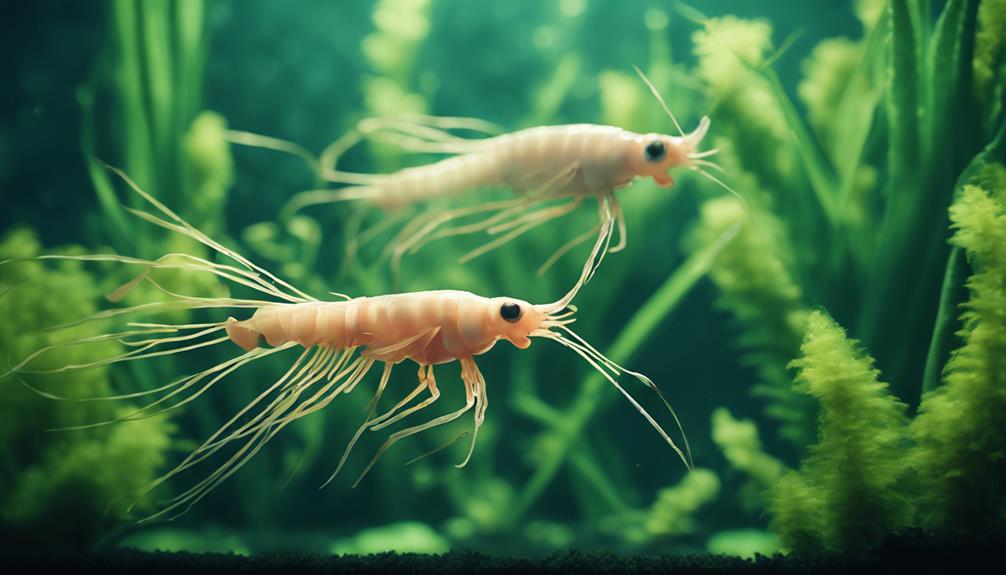You can effectively control algae growth in your waterbody by adopting a combination of natural methods that target different factors contributing to its proliferation. Limit excess nutrients from entering the water by establishing vegetative buffers and preventing debris from entering the waterbody. Balance nutrient levels naturally by focusing on phosphorus remediation. Introduce beneficial bacteria and enzymes to break down organic matter, and install aeration systems to promote oxygenation. Plant aquatic species that absorb excess nutrients, and use natural algaecides like barley straw. Additionally, introduce algae-eating fish species and monitor pH levels to create an environment that inhibits algae growth. By exploring these methods further, you'll discover a thorough approach to maintaining a healthy, balanced ecosystem.
Table of Contents
Key Takeaways
- Prevent excess nutrients from entering the waterbody by establishing a vegetative buffer and limiting fertilizer use around lakes or ponds.
- Introduce beneficial bacteria and enzymes to break down organic matter and recycle nutrients, reducing algae growth.
- Use natural algaecides like barley straw, which releases compounds that inhibit algae growth as it decomposes, to control algae populations.
- Implement nutrient remediation solutions that remove phosphorus from the waterbody, preventing algae blooms and promoting a balanced ecosystem.
- Introduce beneficial aquatic plants like water lilies or cattails that absorb excess nutrients and outcompete algae for resources.
Limit Excess Nutrients Entering Water
To prevent algae growth, you can start by limiting the excess nutrients that enter the waterbody in the first place.
One way to do this is to avoid letting grass clippings, leaves, fertilizer, and other nutrient-loaded organic debris get into the water. These materials are rich in excess nutrients that can fuel algae growth, so keeping them out is vital.
You can also limit mowing around the edges of lakes or ponds to help establish a protective vegetative buffer. This buffer absorbs excess nutrients, preventing them from entering the water.
By planting beneficial vegetation in and around the edges of lakes or ponds, you can stabilize the bank, reduce erosion areas, and keep nutrients from entering the waterbody. This vegetation acts as a natural filter, absorbing excess nutrients and preventing them from contributing to algae growth.
Balance Nutrient Levels Naturally
By focusing on phosphorus, the primary culprit behind nuisance and harmful algal blooms, you can take a crucial step towards balancing nutrient levels naturally in your waterbody.
As the primary limiting nutrient, phosphorus is the key to controlling algae growth.
To achieve balance, you can implement nutrient remediation solutions that remove phosphorus from the waterbody, preventing algae blooms. One effective method is using lanthanum-modified clay, which permanently removes phosphorus from the water column and locks it in the sediment at the bottom of the pond.
Alum is another option, effective in larger waterbodies, which helps remove phosphorus and improve water clarity.
By reducing phosphorus levels, you'll create a healthier environment where beneficial organisms can thrive.
Biological augmentation can further aid in maintaining a balanced ecosystem, reducing the accumulation of nutrients and organic sludge.
Use Beneficial Bacteria and Enzymes

Your waterbody's ecosystem can be substantially enhanced through the introduction of beneficial bacteria and enzymes, which work synergistically to break down organic matter and recycle nutrients.
These microorganisms are naturally occurring in healthy aquatic environments and play a vital role in maintaining ecological balance.
By adding beneficial bacteria and enzymes to your waterbody, you can create an environment that's less conducive to algae growth.
Beneficial bacteria, such as those in the genus Bacillus, are capable of breaking down organic matter like dead plant material, fish waste, and excess nutrients.
Enzymes, on the other hand, accelerate these decomposition processes by catalyzing chemical reactions.
As a result, the availability of nutrients for algae growth is reduced, and the waterbody's overall water quality is improved.
By using beneficial bacteria and enzymes, you can effectively control algae growth without resorting to harsh chemicals or algaecides.
This natural approach not only promotes a healthier ecosystem but also supports the well-being of aquatic life.
Install Aeration Systems Properly
You can further enhance your waterbody's ecosystem by installing aeration systems that promote beneficial aerobic bacteria growth, which in turn helps break down organic matter and consume excess nutrients that might fuel algae growth.
When installing an aeration system, it's vital to place it in an area that maximizes water circulation and oxygen distribution, such as near the pond's center or in areas with poor water circulation.
The type and size of the system should be determined based on your pond's size, depth, and water volume to guarantee adequate oxygenation and circulation.
Regular maintenance is also essential, including cleaning and replacing air stones or diffusers to prevent clogging or damage.
By choosing an energy-efficient pump or windmill-powered system, you can enjoy a cost-effective and environmentally friendly solution for controlling algae growth.
Plant Algae-Controlling Aquatic Species

Introduce beneficial aquatic plants, such as water lilies or cattails, that absorb excess nutrients and outcompete algae for resources, thereby naturally controlling their growth. These plants are a natural and effective way to prevent algae blooms. By incorporating them into your water feature, you'll create a balanced ecosystem where aquatic plants thrive and algae struggles to survive.
Here are some examples of aquatic plants that can help control algae growth:
| Aquatic Plant | Benefits |
|---|---|
| Water Lilies | Absorb excess nutrients, shade the water column, and provide habitat for beneficial organisms |
| Cattails | Outcompete algae for resources, stabilize the water's edge, and provide shelter for aquatic life |
| Hornwort | Release allelochemicals that inhibit algae growth, and provide a natural food source for fish and other aquatic animals |
Apply Natural Algaecides Safely
When seeking to control algae growth, applying natural algaecides safely is crucial to avoid harming other aquatic life, and imperative to explore the various options available.
You can use natural methods like barley straw, which releases compounds that inhibit algae growth as it decomposes.
Another approach is to introduce beneficial bacteria that consume algae, providing an effective and non-toxic way to control algae growth.
Certain plants, such as water lilies and hornwort, can also act as natural algaecides by consuming the same nutrients as algae, outcompeting them for resources.
Lake and pond enzymes are another natural algaecide that can break down algae cells, eliminating them without harming other aquatic life.
When using these natural algaecides, it's crucial to follow the recommended application rates and guidelines to guarantee safe and effective algae control.
By using natural methods, you can maintain a balanced ecosystem while keeping algae growth under control.
Maintain Clean Water Proactively

As you work to maintain clean water proactively, you'll want to focus on two key strategies: limiting nutrient entry and aerating the water.
By doing so, you'll reduce the likelihood of algae growth and create a healthy environment for your aquatic ecosystem.
Limit Nutrient Entry
By taking proactive steps to limit nutrient entry, you can substantially reduce the likelihood of excessive algae growth in your waterbody.
One of the primary causes of algae is the presence of excess nutrients, so controlling what enters your water is crucial.
To do this, avoid letting grass clippings, leaves, fertilizer, and other nutrient-loaded organic debris get into the waterbody.
You can also limit mowing around the edges of lakes or ponds to help establish a protective vegetative buffer that absorbs excess nutrients.
Planting beneficial vegetation in and around the edges of lakes or ponds can stabilize the bank, reduce erosion areas, and keep nutrients from entering the waterbody.
Aquatic plants like pickerelweed, sedges, and rushes can add beauty and provide nutrient absorption to shallow areas.
By establishing a protective vegetative buffer, you'll not only reduce erosion areas but also prevent algae growth.
Aerate the Water
Proper aeration is essential to maintaining a healthy waterbody, as it stimulates the growth of beneficial aerobic bacteria that break down organic matter and prevent algae overgrowth.
When you aerate the water, you're creating an environment where these good bacteria can thrive. As a result, they'll consume algae, reducing their population and promoting a balanced ecosystem.
You can aerate the water using various methods, such as installing waterfalls, fountains, air stones, or windmills. These tools increase oxygen levels, making it difficult for algae to thrive.
Additionally, introducing aerobic bacteria through natural means, like adding beneficial microbes, can further stimulate the breakdown of organic matter and reduce algae growth.
By maintaining healthy oxygen levels, you'll reduce the likelihood of anaerobic conditions that favor algae growth. So, take the proactive approach and aerate the water to prevent algae growth.
With a well-aerated waterbody, you'll be one step closer to a balanced and thriving ecosystem.
Control Algae With Barley Straw
As you explore natural methods to control algae growth, you'll discover the benefits of using barley straw, which inhibits algae growth through the release of specific compounds during decomposition.
You'll learn about the different methods by which barley straw achieves this inhibition, including the release of humic acids and phenolic compounds.
Barley Straw Benefits
You can harness the natural algae-fighting properties of barley straw to keep your pond or lake water clean and clear.
When barley straw decomposes, it releases compounds that inhibit algae growth, making it a natural and effective method for controlling algae. This process takes around 2-3 weeks, during which time it releases a steady supply of algaecides that target and kill algae cells.
What's more, barley straw is a safe and non-toxic method of algae control, posing no harm to fish, plants, or other aquatic life. Plus, it's cost-effective – one bale of barley straw can effectively treat up to 1 acre of water.
By using barley straw, you can naturally control algae growth and maintain a healthy ecosystem. You can also combine it with other natural methods, such as aeration and beneficial bacteria, to create a thorough algae control strategy.
With barley straw, you can enjoy a thriving aquatic environment without relying on harsh chemicals.
Algae Inhibition Methods
About 1-2 bales of barley straw per acre of water surface area can be used to inhibit algae growth, with the bales needing replacement every 2-3 months for ideal results.
As the barley straw decomposes, it releases compounds that control algae growth naturally. This process takes around 2-4 weeks, during which time it releases humic acids, phenolic compounds, and other organic molecules that suppress algae growth.
Barley straw is most effective against green algae, with studies showing a 90% reduction in green algae growth when used in conjunction with other natural methods.
What's more, barley straw is a safe and non-toxic method for controlling algae, making it suitable for use in ponds and aquariums with fish and other aquatic life.
Introduce Algae-Eating Fish Species

One effective strategy for controlling algae growth in ponds and aquariums is to introduce algae-eating fish species, which can efficiently consume and break down excess algae. This natural approach can help combat algae problems and maintain a balanced ecosystem.
You can introduce Siamese algae eaters, Amano shrimp, or Plecos to tackle your algae issues. Siamese algae eaters are particularly effective at consuming green water algae and can be introduced in schools of 5-10 to maximize their impact.
Amano shrimp are efficient at cleaning up algae from glass, plants, and decorations, making them suitable for small to medium-sized aquariums.
Plecos, such as Bristlenose or Rubberlip Plecos, are effective at consuming algae from rocks, driftwood, and other decorations, and can be introduced in small schools.
When introducing algae-eating fish species, it's vital to research and confirm they're compatible with your existing aquatic environment and inhabitants. By doing so, you'll be able to effectively combat algae and maintain a thriving ecosystem.
Monitor and Adjust Ph Levels
Maintaining a stable ph level is essential, as fluctuations can substantially impact algae growth, with levels above 8.5 and below 6.5 creating an environment conducive to its development. To prevent algae growth, you should aim to keep your ph levels between 6.5 and 7.5.
| Ph Level | Effect on Algae Growth |
|---|---|
| Above 8.5 | Encourages algae growth |
| Below 6.5 | Favors algae development |
| 6.5-7.5 | Inhibits algae growth |
Regular water testing is pivotal to detect any ph imbalances, and adjustments should be made promptly to prevent algae growth. You can use natural methods like adding peat moss or driftwood to lower ph levels, while baking soda or soda ash can raise them. Remember, achieving a stable ph level requires ongoing monitoring and adjustments, as it can fluctuate due to factors like rain, fertilizers, and decaying organic matter. By keeping your ph levels in check, you'll be well on your way to a balanced and healthy pond, perfect for pond maintenance and Regular water testing.
Frequently Asked Questions
What Natural Remedy Kills Algae?
You can explore algae predators like zooplankton or introduce UV filtering to control algae growth. Alternatively, you can try using barley straw, which releases compounds that inhibit algae growth as it decomposes.
How to Control Pond Algae Naturally?
You can control pond algae naturally by implementing pond aeration methods, like waterfalls or air stones, to improve water circulation techniques, which foster beneficial bacteria growth, breaking down organic matter and preventing algae overgrowth.
Does Vinegar Stop Algae Growth?
You'll find that vinegar effectively stops algae growth when applied correctly; using a 5-10% concentration, applying it regularly, and adjusting the frequency based on algae severity will help you achieve a balanced aquatic environment.
What Plants Reduce Algae Growth?
You'll find that certain aquatic plants, like Water Lilies, are natural Algae Fighters, reducing algae growth by absorbing excess nutrients. These Aquatic Helpers create a balanced ecosystem, allowing you to enjoy a thriving, algae-free environment.
Conclusion
You've taken the first step towards a balanced ecosystem by exploring these 10 natural ways to control algae growth.
Notably, research supports the theory that algae blooms can be an indicator of a larger issue – eutrophication.
By addressing the root causes of excess nutrients, you're not only controlling algae, but also mitigating the effects of eutrophication.
By incorporating these methods, you'll be well on your way to creating a thriving, sustainable aquatic environment.

